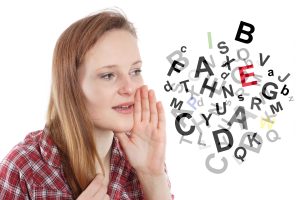Dyspraxia is caused by injury to areas of the brain which control the planning and coordination of movement and to the neurological networks linking these areas. Dyspraxia refers to impairment of the ability to plan and combine sequences of movements which are necessary to perform learned, volitional actions. Dyspraxia can impair the person’s ability to perform any purposeful physical movements including speech and other actions related to communication (e.g. using sign language, writing, social messaging).
Dyspraxia affecting speech can be known as apraxia of speech, verbal dyspraxia and articulatory dyspraxia. It affects the person’s ability to initiate, plan, co-ordinate and produce sequences of speech sounds in order to accurately articulate words. Dyspraxia itself does not impair understanding of language or intellectual abilities but may co-exist with dysphasia and cognitive impairment which do affect these abilities. Dyspraxia may also occur in conjunction with dysarthria (impaired articulation resulting from changes to facial muscle tone, strength and coordination).
The speech of the person with acquired dyspraxia may be characterised by the following:
- Attempts to produce speech appear effortful.
- Speech sounds can sound distorted.
- Incorrect speech sounds may be used or speech sounds may be omitted from words.
- The person may be observed to make groping movements of tongue and lips in order to try and produce the sequence of movements required for clear speech.
- Production of combinations of speech sounds that fail to produce a recognisable word, the word may sound made up. Such words are known as neologisms.
- Inconsistent speech errors. The person may pronounce the same word differently on different occasions.
- Changed patterns of intonation.
- Speech lacking normal rhythm and flow. Speech rate may be slow.
- The person will find it difficult to accurately imitate individual sounds, words or phrases; will struggle to repeat when asked.
- Short sentences.
- Poor intelligibility.
- Severe dyspraxia may cause the person to be unable to produce any volitional sounds at all.
The person with dyspraxia is likely to be more successful at producing spontaneous, automatic speech responses (e.g. such as greetings, swear words) when compared with their ability to produce planned, purposeful speech.
 The person with dyspraxia may have significant difficulties successfully communicating even basic information. Even their yes/no responses may be inaccurate. This may extend to the use of non-verbal communication such as nodding, shaking the head or thumbs up/down gestures. The person may indicate yes when they mean no and vice-versa.
The person with dyspraxia may have significant difficulties successfully communicating even basic information. Even their yes/no responses may be inaccurate. This may extend to the use of non-verbal communication such as nodding, shaking the head or thumbs up/down gestures. The person may indicate yes when they mean no and vice-versa.
Unless the person also has dysarthria, the muscle strength and co-ordination for spontaneous everyday functions will remain unchanged (e.g. movements needed for eating, drinking, smiling, laughing, yawning).
The person may be observed to spontaneously whistle, put their tongue out to lick their lips, make tut-tut noises etc. However, when then asked to deliberately and purposefully carry out these actions, the person with dyspraxia will often be unable to do so.
Dyspraxia often co-exists with dysarthria and dysphasia. It is highly distressing and can be difficult to treat. Because most communication relies on the production of planned, purposeful actions it can be difficult for the person with dyspraxia affecting limb movement to use Augmentative and Alternative methods of communication.
How to Help the Person with Communication Impairments Arising from Dyspraxia